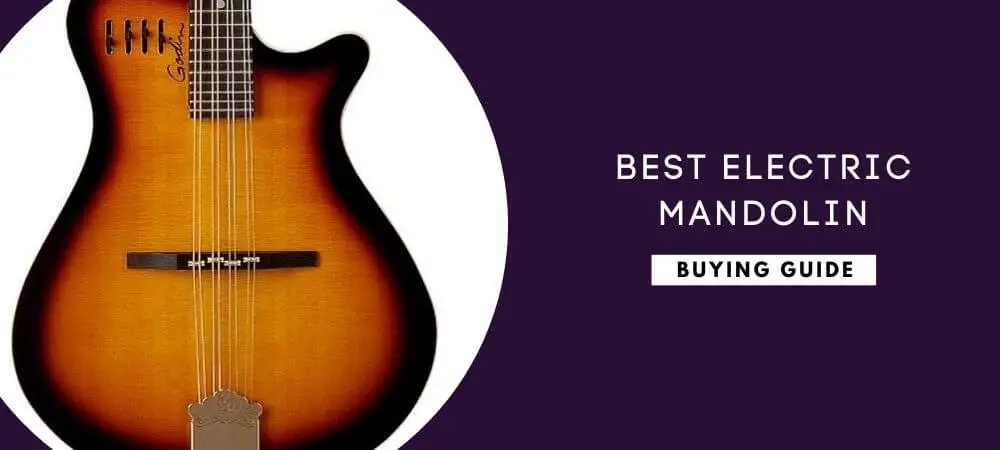Having the best electric mandolin could entirely revolutionize your mandolin playing experience. You’ll be exposed to a whole new tonal pallet and get to experiment with an entirely different sound spectrum.
Some purists shun electric mandolins, citing that it compromises a classic instrument’s integrity with electronic components.
Well, as you will find out, the electric mandolin isn’t meant to compete with the regular acoustic mandolin. Rather, these instruments are designed with different musical styles and playing experiences in mind, and each has a unique sound quality.
Table of Contents
Best Electric Mandolins To Buy In 2024
1. Ibanez A Style Mandolin Review: Best Electric Mandolin Overall
This A style mandolin is incredibly affordable for an electric, making it the best electric mandolin for a player who may be on a tight budget.
For the price, this mandolin has an excellent build quality.
It is constructed using a spruce top and a mahogany body and comes complete with a single-coil magnetic pickup.
It has a clean, crisp sound that projects incredibly well whether you play it plugged in or unplugged.
No products found.
The playability of the 8-string instrument is just as impressive, thanks to the comfortable maple neck and rosewood fingerboard.
This A-style electric mandolin comes with two knobs serving as the volume and tone controls to adjust the sound as desired.
- Very comfortable and easy to play.
- Crisp warm sound.
- Affordably priced.
- Mandolin’s case is not included.
No products found.
2. Vangoa A Style Electric Mandolin Review
This vangoa mandolin is made of premium mahogany wood, complete with an elegant glossy red sunburst finish. Just by looking at it, you can tell that this is a high-quality mandolin.
The preinstalled pickup system comes with controls for the volume and tone, which comes in handy to satisfy the various needs you may have when playing different styles of music.
Unplugged, the instrument plays just as beautifully, giving off a rich sound that’s warm and bright.
The mandolin features fully closed tuning pegs designed to maintain a more stable pitch, keeping the instrument in tune for longer.
This mandolin comes complete with many accessories, which makes it the best electric mandolin for a first-time mandolin player.
You get a clip-on tuner, extra strings, picks, a strap, and a padded gig bag.
- The action is very smooth and low.
- Comes with a lot of extra accessories.
- Rich, warm tone.
- Requires a comprehensive setup before playing.
3. Gold Tone GME-4 Mandolin Review: Best Electric Mandolin For Playability
This solid body Gold Tone mandolin is a 4-string model, and it would be the best electric mandolin for rock, swing, and jazz musicians.
It comes with a stacked humbucking pickup that’s guaranteed to deliver a powerful sound with no feedback.
The pickup is very quiet and comes with knobs to help control the tone and volume.
The adjustable bridge conveniently allows for individual string adjustment, while the narrow maple neck and radiused fingerboard make the instrument very easy to play.
This particular model is right-handed, but the mandolin is also available in a left-handed model.
- Excellent tonal balance.
- Sturdy and very well made.
- Very easy to play.
- The strings are a bit too closely spaced on the fretboard.
4. Seagull S8 Electric Mandolin Review: Best Electric Mandolin For Travel
This Seagull S8 has a solid spruce top and a maple body, complete with a hand-finished neck and a custom polished finish.
This solid construction speaks of its quality.
The mandolin not only feels great, but it also has a superb sound resulting from the high-fidelity piezoelectric pickup system that’s been used.
Additionally, the mandolin has an inbuilt proprietary preamp which is exactly what you’d want from the best mandolins.
This instrument delivers brilliant acoustic tones, and it keeps in tune perfectly well because of the open geared machine head.
- Sleek, solid construction.
- Superb sound quality.
- Affordably priced.
- The bridge may require some adjusting.
5. Stagg M50E Electric Mandolin Review: Best Electric Mandolin For Bluegrass
Bluegrass musicians use either A style mandolins or F style mandolins when playing acoustically, and not many of them embrace the electric instruments.
When they do, however, they end up falling in love with the sound of the Stagg M50E.
This bluegrass mandolin plays great right out of the box, and you will hardly need any setup on it before you’re strumming away to your favorite tunes.
It is an 8-string instrument and comes with one single-coil pickup and control knobs for volume and tone.
The adjustable bridge makes it extremely easy to replace strings which is a convenient feature to have.
- Great playability.
- Amazing tone.
- Holds tuning.
- The neck doesn’t have an adjustable truss rod.
6. Ibanez M510E Electric Mandolin Review: Best Cheap Mandolin
The Ibanez M510E is a quality instrument at an excellent beginner-friendly price.
It doesn’t get any better than that, now does it?
It comes with a single-coil pickup so you can play it acoustically, unplugged, or electrically while plugged in.
Whichever you choose, you will love the rich, warm lows and sweet sustain offered by the instrument.
All in all, this would be the best electric mandolin to buy on a whim.
- Quality build using quality components.
- Very comfortable and easy to play.
- Great sound and decent action.
- Does not come with a bag or case.
7. Oscar Schmidt OM10E Review: Best For Live Performances
If you are looking for a mandolin that can guarantee zero feedback during live performances, this Oscar Schmidt is the best electric mandolin for you.
This A style instrument features a spruce top and mahogany body because it is designed to last a lifetime.
It even comes with a lifetime warranty just to keep your mind at ease.
The piezoelectric pickup sounds greatly amplified, and the sound is just as rich if you play it acoustically.
- Amazing value for money.
- Plays and chords extremely well.
- Has a lifetime warranty.
- Does not come with a case.
8. Kentucky KM-300E, 4-String Electric Mandolin Review
The 4-string configuration on this mandolin makes for much easier fretting.
Making this the best electric mandolin for much older or much younger players who may be struggling with the standard 8 strings.
Playability is further enhanced by the arched back, the radiused fretboard, and the adjustable ebony bridge.
The single council pickup sounds amazing, and it is in a cool-looking classic lipstick style that beautifully complements the solid basswood construction.
- Enhanced playing comfort.
- Beautiful, sturdy design.
- Impressive tone and sustain.
- Lacks the signature mandolin sound.
9. Vangoa Electric Mandolin Review: Best Electric Mandolin For Beginners
This is rated as the best electric mandolin for beginners, but experienced players will like it just the same.
The instrument features excellent craftsmanship from basswood.
Basswood is a quality tonewood, which enhances the crisp, ethereal sound produced, especially when playing acoustic.
Furthermore, the arched back offers better resonance making the sound clear and crisp.
Also, the dense mahogany bridge allows for food conduction of the vibrations produced, transferring them to the pickup.
- Comes ready to tune and play right out of the box.
- Has perfect neck action.
- Sounds really good.
- None.
Buying Guide For Electric Mandolin
Types Of Electric Mandolins
The two basic styles of electric mandolin are the Acoustic-Electric mandolin and the semi-hollow electric mandolin.
a) Acoustic-Electric Mandolins
The piezoelectric pickups convert the vibrations from the strings into electrical impulses. These electrical signals are then transmitted to an amplifier which is an external sound system.
So you can think of acoustic electric mandolins as a hybrid between an acoustic mandolin and an electric mandolin.
Acoustic electric mandolins typically come with eight strings, and they tend to have that iconic signature mandolin tone, which makes them the best mandolins for bluegrass and folk music.
b) Semi-Hollow Electric Mandolins
This electric mandolin has features similar to the electric guitar, and some people think of them as essentially little electric guitars.
To begin with, this is exactly an accurate assumption because the two instruments have a very different tonal pallet and sound range. Nevertheless, the semi-hollow mandolin uses the same concept as the semi-hollow guitar.
Semi-hollow electric mandolins are actually the best electric mandolin to use in situations where feedback is a concern.
The downside, however, is that the central wood blocking also reduces the overall tone quality and decreases the sound produced by the instrument. You will find that semi-hollow mandolins sound more like a guitar rather than having a mandolin-like sound and tone.
Semi-hollow mandolins come in various models. You can find a 4-string, 5-string, and 8-string electric mandolin. The 4-string and 5-string mandolins have single strings, and these sound a lot like a small guitar.
These are the best mandolin models for Western swing, blues, jazz, and rock music.
The 8-string mandolin is double-strung, and this sounds much more like a regular mandolin because even when plugged in, it retains the double course mandolin signature sound we know and love.
c) Modified Acoustic Mandolins
The cheapest way to amplify an acoustic mandolin would be to install a piezoelectric pickup under the bridge of your regular mandolin. There are plenty of aftermarket electric pickups that work very well. You can either choose a single-coil pickup or a humbucker pickup.
Of course, this is a pretty intricate process, and you are better off having that installation done professionally by an experienced luthier.
Mandolin pickups are often passive, unlike the active ones found on an acoustic guitar. Active pickups use a power source to boost the output, and this power source is usually a 9V battery. Passive pickups, on the other hand, send a less powerful signal.
As a result, you may be better off investing in a good preamp or a direct box to boost your signals. However, the advantage is that you can comfortably play the electric instrument acoustically and only plug it in when needed.
The second way to amplify an acoustic mandolin would be to use an electromagnetic pickup similar to what’s usually found in a violin or a cello. Magnetic pickups work by sensing string motion in a magnetic field, and the electric signals are produced by the mandolin’s steel strings vibrating in the magnetic field of the pickup.
The problem might be that a magnetic pickup will be inadequate on a less resonant mandolin with a thick soundboard, and this is because there wouldn’t be enough top movement to be captured by the magnetic pickups.
A thinner, more resonant top would be preferred. However, thicker tops are the more popular kind because they are cheaper to mass-produce. As such, with an electromagnetic pickup, you would not be getting the woody sound many get from their instruments when using an electric acoustic mandolin or a microphone.
People often fight for good sound from an external pickup, especially because they often have to try getting more bass into the signal. Bass frequencies take more energy to produce, whereas higher tones come more naturally to the mandolin.
Benefits Of Electric Mandolins
a) Louder Acoustic Tone
Electric mandolins are great when you need a louder acoustic tone, such as when playing in large venues, loud bars, clubs, etc.
Mandolin is a rather quiet instrument, and if you mostly play at home, in front of small audiences like at an acoustic jam session, or even in a mandolin orchestra, you may never need a pickup.
However, if you have ever played in a loud band, then you must have come across the challenge whereby your acoustic instrument simply wasn’t loud enough to get heard over other instruments.
This is when an electric mandolin would come in handy. Purists insist that if a louder tone is what you are after, using a microphone with your regular mandolin is far better than using an electric mandolin.
On the other hand, some mandolinists use a microphone and plug in their instrument simultaneously for an enhanced acoustic tone.
Having a good microphone that goes into the soundboard of your mandolin is definitely one approach you can use to get a louder volume from your instrument. However, using an electric mandolin is also a great option to achieve the same goal.
Additionally, playing into a microphone might only be a viable option if you perform in a studio where the acoustics are pretty controlled. When playing outside at a gig, it may not always be a practical choice because you will be very prone to feedback.
b) Almost Silent Unplugged
Electric mandolins are smaller and lighter than acoustic mandolins, and as such, they are quieter as well. If you live in an area where noise might be an issue while practicing on your mandolin, then getting an acoustic electric mandolin might be a good idea.
This is because these mandolin styles can either be played plugged into an amplifier or unplugged and when playing unplugged, they sound just as good as a regular mandolin. Only quieter. This way, you can practice late into the night without offending the neighbors.
c) New Sound Spectrum
Electric mandolins have a very unique tonal pallet and sound range that’s quite different from their acoustic counterparts.
This opens you up to a whole new sound spectrum that you can experiment with and see how it plays out with the type of music you play.
Whether you play bluegrass, western swing, jazz, or blues, you might be amazed at how much an acoustic mandolin can elevate your sound.
d) Special Effects
Mandolinists recording in a studio or even playing in front of a live audience may opt to use an electric guitar purely for the special effects that this instrument accords them.
When using a semi-hollow mandolin, the player uses electric pedals similar to what’s used on electric guitars, which can give certain special effects and distortion to the mandolin sound.
If you want something other than the basic acoustic mandolin sound, you can make these cool-sounding pedals produce any kind of effect on your instrument. From dreamy, psychedelic sounds to spacey echos, electric pedals come with many bells and whistles, and you can get many effects out of them.
e) Clean Acoustic Sound
If you have the right setup, an electric mandolin is guaranteed to give you clean, clear tones with lots of sustain. The electric aspect smoothes and extends the single notes, so they are less crisp than acoustic instruments. However, the courses still create a nice chime true to the mandolin.
The clean acoustic sound is thanks to the fact that electric mandolins have clean signals, as long as you have a high-quality pickup and use a decent amp, be it an acoustic amp or a tube amp.
The ideal amp should give you decent volume at low gain so that you don’t end up with a distorted sound.
Pickups add oomph to the instrument, giving it a nicely defined mid and high-end. It is important, though, to ensure your electric musical instrument has volume and tone controls. This is because there are often string-to-string volume variances, especially when it comes to the E-string.
f) Increased Sustain
Mandolins are known to have a woody, fast decay. However, electric mandolins have a longer ringing sustain than their acoustic counterparts, and this is a feature many players seem to love about these electrics.
Some mandolinists love sustain, and others, especially those that play bluegrass music, don’t.
The best part about having sustain is that you can choose to use it or not to. When you want to play a more staccato style and don’t need the sustain, you can easily cop it off. And when you do want the sustain, just let the chord strum ring on.
Features To Consider When Choosing An Electric Mandolin
Number and Types of Pickups
Pickups can make a big difference, and just like any component on the mandolin, you have a choice between high-quality pickups and inferior quality pickups.
Some pickup brands have lower output while others have a higher output. Some pickups have a little more noise than others. At the same time, depending on their efficiency and performance, the number of pickups used may vary. Some mandolins have one pickup, others have 3 pickups.
Number of Strings
We have 4-string and 5-string electric mandolins, which are single-course instruments, then we have the more familiar 8-string electric mandolin having double strings.
An electric mandolin with 4 or 5 single strings is more favored by jazz players and mandolinists who play such styles of music as western swing and blues.
Electric mandolins that have eight strings can at times sound like they have too many overtones. For some people, however, this slight dissonance is an integral aspect of the signature mandolin sound.
The argument is that 4- and 5-string electric mandolins sound too much like a guitar, which beats the point of playing the mandolin in the first place.
Semi-Hollow Vs. Acoustic Electric Mandolin
If you want some warmth in your tone, the best electric mandolin to get would be the semi-hollow electric mandolin.
However, semi-hollow mandolins are still prone to feedback when playing at loud volumes. Acoustic electric mandolins pretty much eliminate this problem.
Electric Mandolins FAQs
Are There Electric Mandolins?
Yes, there are.
The idea of an electric mandolin may seem like a modern thing, but it really isn’t. The first electric mandolin was built in the United States as early as the late 1920s, and this was developed so that in a band setting, the mandolin could be heard alongside much louder instruments.
Since then, their popularity has increased gradually, with many performers enjoying the fact that the electric model allows them some mobility on stage while playing.
How Much Do Electric Mandolins Cost?
The best electric mandolin will set you back not less than $500 for a new one.
There is no fixed pricing because, ultimately, the instrument’s brand and build quality will influence how much an electric mandolin costs.
You can get a cheap mandolin for less than $500, but there is no guarantee that this will give you the best performance. If you really must go for a cheap electric mandolin, consider buying a good quality used one and have it set up by a luthier.
Where To Buy Electric Mandolins?
Wherever you find an acoustic mandolin, you can be sure to find an electric one as well. You can buy an electric mandolin from the manufacturer’s website, online stores such as Amazon and eBay, or a physical music shop near you.
Wherever you buy it, make sure the seller is certified and that they are selling you a genuine instrument. Try and avoid making such a purchase from a nondescript website as, more often than not, these tend to be fraudulent sites.
What Are The Best Brands For Electric Mandolins?
Rigel has long been known for having exceptional pickups, and their Gold Tone mandolin is actually one of the brand’s most sought-after electric mandolins.
Jonathan Mann and J.L. Smith are excellent mandolin brands that make some of the best electric mandolins in the market. However, their instruments tend to be priced on the higher end, so you will end up parting with quite a bit of cash.
If you are a beginner mandolin player, or you simply don’t have the funds, you can start on a lower price range. Eastwood and Morgan Monroe are some other brands with very good electric mandolins that are more affordably priced.
Conclusion
An electric mandolin can be very fun, especially if you play around with pedals and all the special effects.
Ultimately, playing any musical instrument is all about experimenting with and broadening your sound range, and the best electric mandolin will help you do just that.












